Pipe cutter for polypropylene pipes: overview of types of tools and features of working with them
When installing indoor water supply, sewerage and heating pipelines, plastic pipes have to be cut in large quantities. It is not recommended to use improvised means for this due to many potential problems in the future.
For cutting you need a professional tool. And it is better to take a special pipe cutter for polypropylene pipes, the use of which guarantees an even cut without burrs.
We will tell you how to choose equipment for cutting polypropylene pipes, describe the device and principle of operation, and also outline the main criteria for choosing pipe cutters.
The content of the article:
Types of pipe cutting equipment
In stores, tools for cutting polypropylene (PP) pipes are offered in a variety of ways. These are both manual mechanical and electrical devices.
Each of them has its own merits. The most suitable equipment should be selected based on the volume of work and its complexity.
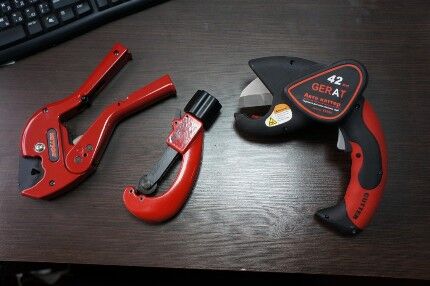
When choosing equipment for cutting polypropylene pipes, the main attention should be paid to two points:
- The blade must be made of alloy steel.
- Each pipe cutter model has two indicators - the minimum and maximum pipe size. This range should be selected so that it is sufficient to complete the work.
The body material of such equipment is usually made of metal.And it's best when it's aluminum, not steel. A pipe cutter with aluminum handles is light in weight and requires less effort to operate. Soft polypropylene pipes do not require excessive effort when cutting. An aluminum tool will cope with the resulting loads without problems.
A pipe cutter can have replaceable or non-replaceable cutters. Sooner or later they will wear out. In the second case, the tools will have to be purchased again. However, if the cutting apparatus is needed for a one-time job, then it is better to take a cheaper model with permanent equipment.
Option #1 - guillotine
The simplest pipe cutting equipment in terms of design and precise cut quality is guillotine shears. They can be manual or electric. Structurally, this is a blade lowered onto a polypropylene pipe, which makes an even cut and strictly perpendicular to the longitudinal line.
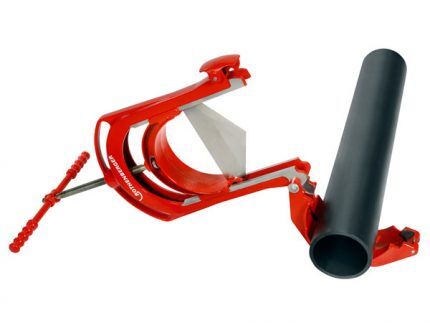
Most manual guillotines are designed for cutting tubular products with a cross-section of up to 70 mm. But some models are also capable of diameters of 100–150 mm. This is quite enough to perform installation work at home. Everything above applies to industrial equipment.
As the knife presses on the soft polypropylene, it easily rips it apart. There is no deformation of the pipe due to the sharpness of the Teflon-coated cutter and the smoothness of its movement. After cutting the polypropylene, additional processing of the end is no longer required. The pipe is completely ready for butt soldering and using fittings.
The only drawback of guillotines that is worthy of mention is the low speed of work.Each time the blade must be returned to its original position by long unscrewing the rod. But the cut turns out to be perfectly even, and for this you can twist the handle. However, if you plan to cut a lot of polypropylene pipes, then it is better to choose a different type of pipe cutter.
Option #2 - ratchet
This class of pipe cutting tool is shaped like ordinary scissors with two handles. They only have a blade on one side. The second half is made in the form of a semicircular stop, where the pipe should be placed when cutting.
They are equipped with a ratchet mechanism so that the knife moves smoothly and requires a minimum of effort.
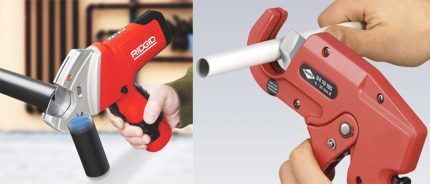
The main disadvantages of this cutting equipment are the high probability of obtaining an oblique cut and possible collapse of the pipe. They are actually large hand scissors. You need to use them skillfully.Our website has a detailed article on how to use this type of pipe cutter. More details - go link.
Due to inexperience, the slightest tilt in the hands leads to the formation of a crooked end, which then has to be sharpened. And if the pipe is also wrinkled, then it will need to be straightened from the inside with a calibrator.
Pistol pipe cutters with a ratchet mechanism also belong to this type. They are much easier to work with. You have to apply very little effort for cutting, and the cut is more even.
The return of the knife to its original position occurs entirely as a result of pressing a button due to a spring. This is the best option for cutting polypropylene pipes with thicker and harder walls.
Option #3 - roller
The next type of pipe cutter is a roller cutter. It has one or more rollers in its design. This tool looks like a hook. Inside this hook there are movable wheels on which the pipe being cut rests.
The cut itself is made by another cutting roller-knife, which is pulled out from the handle on a telescopic extension.
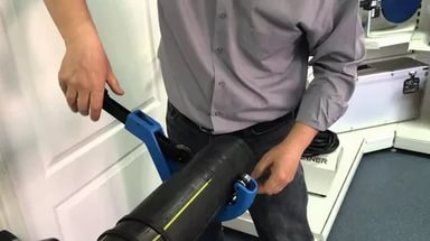
Cutting polypropylene occurs as a result of turning the roller pipe cutter around the pipe clamped in it. Here it is important to rotate it so that the cutting line in the plastic does not go away from the starting point.
The cutting roller should end the circle in the same place where it started.If you have to cut thick pipe walls, you will need to make a revolution around the pipe several times, gradually pressing the cutter deeper into the plastic by turning the screw on the handle.
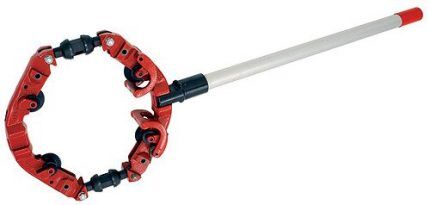
When used correctly and accurately holding the knife along the line, the cut resulting from the use of a roller pipe cutter is perfectly straight. In this regard, it is comparable to a guillotine.
But it cuts pipes much faster, but also costs more. Plus, the slightest accidental shift of the knife to the side leads to the appearance of burrs at the cut site, which must be subsequently removed.
When cutting polypropylene with a roller pipe cutter, do not over-tighten the handle, pressing the blade disc too hard against the surface being cut. Microcracks may form in the plastic, which will reduce the strength of the pipe and may lead to chips at the end.
Everything should be done smoothly and slowly. This is especially true when working with thick-walled and large-diameter sewer pipelines.
How and how not to cut polypropylene?
In addition to the above specialized pipe cutters, polypropylene pipes can be cut:
- hacksaw;
- jigsaw at low speed;
- from the inside with a drill with a disk attachment.
One "BUT". As a result of using these “improvised” tools, the edges of the pipe are torn. This is not only unsightly, but also unacceptable.
Before soldering The pipe ends must be cleared of all burrs and leveled, otherwise the connection will be unstable. Such aggressive cutting almost always leads to problems in the installed pipeline in the future.
Using an angle grinder is not recommended. Due to the high rotation speed of its disk, the polypropylene pipe will begin to heat up and melt. A similar situation can occur when using an electric jigsaw if it is turned on at full power.
These tools should be used to cut plastic only as a last resort, when nothing else is at hand.
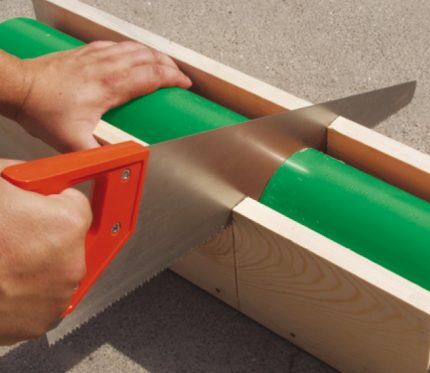
Regardless of the tool chosen, under no circumstances should you put too much pressure on the polypropylene pipe when cutting. This applies to the use of both grinders and professional pipe cutters.
Efforts should be increased gradually, otherwise the plastic may simply crack. Under strong pressure, invisible damage can occur in PP pipe walls, which can then lead to a rupture of the pipeline.
There is another argument against strong pressure from a cutting tool on a polypropylene pipe - deformation in terms of geometry. The walls at the point of such pressure begin to cave in, which is why the cross-sectional section turns from a circle into an oval. And the end for welding with the fitting must be perfectly round. You will have to straighten it later with a calibrator, which will require time and effort.
To prevent the walls from bending, a pair of round blocks of wood of slightly smaller diameter should be inserted into the pipe being cut. The knife will have to pass between them when cutting polypropylene. This way the plastic will definitely not bend, but will be cut as it should.
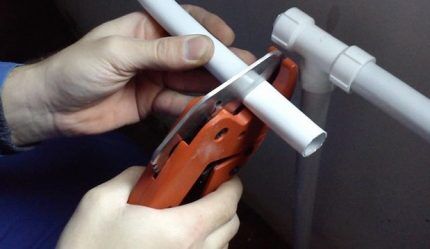
You should absolutely not use a band saw or circular saw for cutting. Polypropylene is too soft and at the same time too fragile for them. On the one hand, the pipe can be torn out of your hands, but on the other hand, it definitely won’t do without chips and cracks at the cut site.
For cutting, use pipe cutters designed for metal pipes, is also not recommended. Their knives are made of a different material with slightly different characteristics.
They will not cut plastic, but tear it. The only exceptions are universal tools for all types of pipelines. But they cost a lot, this is more an option for professional plumbers.
Choosing a pipe cutter - mechanical vs electric
In everyday life, for one-time work, it is recommended to use hand-held cutting tools. It costs less than an electric one and is easier to use.
If you need to make several cuts to install a water supply in a private house or apartment in the area from the riser to some plumbing, then this is simply the ideal choice. However, with large volumes of work, cutting pipes with it will take a lot of effort and time.
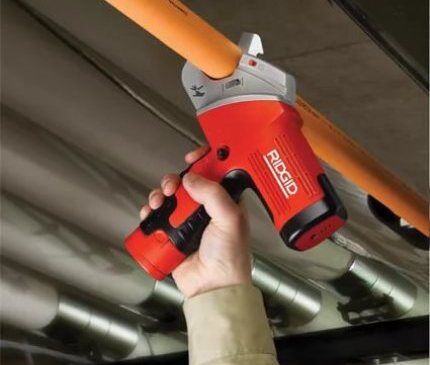
Electrical equipment will cost more than its mechanical counterpart. But it greatly facilitates and speeds up the process of cutting polypropylene pipes. The result is smoother edges. In this case, you do not have to exert force to press the handle; you just need to hold the electric pipe cutter exactly along the cutting line. Errors are practically eliminated.
Every power tool requires power to operate. If there are problems with this (electricity has not yet been connected to the newly built house or accidents constantly occur), then it is better to prefer a manual pipe cutter. You will have to work hard and put in effort, but the installation of water supply and sewerage will be completed on time without delays.
The manual pipe cutter has compact dimensions. It is often simply impossible to bring a bulky electrical analogue to an already installed pipeline in order to make a tie-in into it. But with hand scissors you can make such a cut without any problems.
An alternative to both of these pipe cutter options is an electric one with a removable battery. Such a tool weighs only 1.5–2 kg.The electric drive makes the cutting process easier, but you don’t have to look for an outlet to connect such “scissors.” The battery usually lasts for a couple of hundred cuts, which is quite enough for a full day of work.
Conclusions and useful video on the topic
In order for the pipeline assembly to be successful, the tool for cutting polypropylene pipes must be chosen correctly. Not every pipe cutter is suitable for this type of work.
You still need to learn how to use it, after first testing it on an unnecessary piece of pipe. The video reviews below will definitely help you navigate choosing this equipment.
Review of various scissors for cutting polypropylene pipes:
Comparison of different methods for cutting plastic pipes:
How to use a ratchet pipe cutter:
Without a pipe cutter in hand, it is difficult to install a polypropylene pipeline; cutting pipes will take a lot of time. You need to purchase one or another version of cutting equipment. However, you should choose it wisely in the store. And before using it, it wouldn’t hurt to carefully study the operating instructions attached to the tool; after all, this is a specialized professional tool.
Looking for a pipe cutter for home use? Or do you already have experience working with similar equipment? Please leave your comments, share your experience, and ask questions about the topic of the article in the block below.



